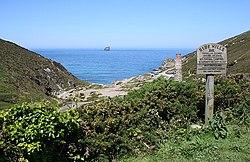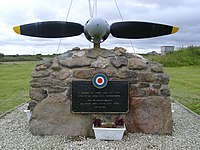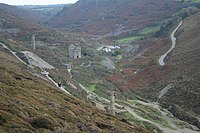Trevellas
| Trevellas | |
| Cornwall | |
|---|---|
 From Trevellas Coombe to the Sea | |
| Location | |
| Grid reference: | SW741521 |
| Location: | 50°19’30"N, 5°10’26"W |
| Data | |
| Post town: | St Agnes |
| Postcode: | TR5 |
| Local Government | |
| Council: | Cornwall |
| Parliamentary constituency: |
Truro & Falmouth |
Trevellas is a village in Cornwall, situated midway between St Agnes and Perranporth.
The village was first recorded as a place in Cornwall in 1302 and was the site of the Trevelles family manor. Trevellas valley was a mining site for centuries and known as the "Blue Hills" coloured by bluish slate.
During Second World War the nearby Perranporth airport was used as a Royal Air Force base.
Geography
There are many scenic cliff path walks around the area, static caravan sites and walks in Woodland Trust wooded areas.[1] Interesting features along the coast include Trevellas Porth,[2] which is popular with divers and fishermen, but because it is quite rocky it is not recommended for swimming.[3]
-
Bawden Rocks from Trevellas Coombe
-
St Agnes, Trevellas Porth
-
Trevellas Coombe and Blue Hills Tin Mine
-
Blue Hills Tin Streams. Water-powered Cornish Stamps used for dressing tin.
The area towards Trevellas Porth is known as "Blue Hills" due to bluish in-ground slate. Trevellas valley has been a site for tin mining for several centuries, and in 1810 the Blue Hills Sett incorporated many of the small mines. Though Blue Hills closed in 1897, tin production has continued in Trevellas to the present and the Blue Hills works can be visited between April and October each year.[4]
History and antiquities
Antiquities
A Bronze Age barrow site lies at the end of one of the Trevellas Airfield runways. Excavated in 1940 by Charles Kenneth Croft Andrew, the site is believed to be a tumulus or burial site that had a bucket urn and pottery sherds. It was defined as an "intact ritual deposit", probably from about 2000 BC. There are no sign of its former shape.[5]
History

Trevellas is first recorded in 1302, and was for several generations the seat of the Trevelles Family. The Trevellas country house was built during the Middle Ages. At some time between 1540 and 1901 a new house was erected where the country house once stood.[6]
The estate then passed through the families of Kearne, Croker, St. Aubyn, Donnithorne and finally the Chilcots. In Lysons's Magna Britannia it states the following:
| “ | Treuellis or Trevellis, a tenement in the manor of Tywarnhaile, was for several descents the seat of the family of Crocker; it belonged afterwards to Mr. Joseph Donnithorne, and is now the property of Mr. Chilcot. The mansion is occupied as a farm-house. | ” |
The estate was broken up in several sales, the final one being in 1948.
The village had a post office and shop until the 1980s when it was closed and is now divided into two dwellings. The shop was owned by Mrs Menadue and was known as Menadue drapers and store. It was famed for its ginger beer. Until the late 1990s Trevellas also boasted a garage and petrol filling station known as Lewis' Garage. Since 1999 the site has been occupied by a thriving camping and caravanning centre called Aztec Leisure.[7]

Perranporth Airfield
Second World War
In Second World War the nearby Perranporth Airfield was used as a base for the Royal Air Force. It became operational on 28 April 1941. At the height of the war over nineteen spitfire squadrons from Australia, France, Canada, Poland, Czechoslovakia and the U.K were based there.[8]
On 13 September 1943 Supermarine Spitfire Vc EE727 FU-? Of 453 Squadron Royal Australian Air Force returning to Perranporth crashed onto the cottage at Trevellas occupied by a woman and her four-year-old son. The woman was seriously injured and the son was killed.[9] He is buried in St Agnes cemetery. The pilot 414505 Flight Sgt Mervyn Francis Nolan RAAF was also killed.[10]
After the War
The land was supposed to be handed back to the local residents at the end of the war but fell into disrepair until the purchase as a private airfield.
The area is a ‘site of scientific interest’.

Miscellany
John Opie, the painter known as The Cornish Wonder, was born here.[11]
Outside links
| ("Wikimedia Commons" has material about Trevellas) |
References
- ↑ Trevellas Woods Woodland Trust
- ↑ Trevellas Porth. Explore Britain
- ↑ Beaches at St Agnes. Cornwall Tourism Magazine. 21 September 2012.
- ↑ Blue Hills Tin
- ↑ National Monuments Record: No. 428340 – Trevellas Barrow
- ↑ National Monuments Record: No. 428389 – Trevellas House
- ↑ Aztec Leisure
- ↑ Perranporth Airfield
- ↑ "Index entry". FreeBMD. ONS. http://www.freebmd.org.uk/cgi/information.pl?cite=HQPaAG3%2BwgTfqHVUpGAW9g&scan=1. Retrieved 6 December 2012.
- ↑ RAF Davidstow Crash Log 1943
- ↑ Hendra, Viv (2007). The Cornish Wonder, A Portrait of John Opie. Truro: Dyllansow Truran. pp. 3. ISBN 978-1-85022-216-3.




